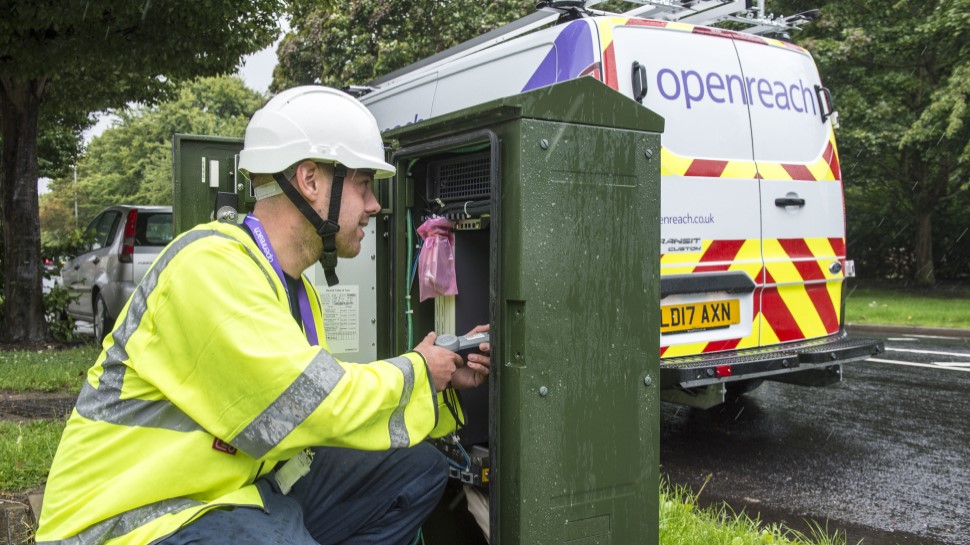One million premises in the UK have now been upgraded to gigabit broadband

- A new building has been connected every 6 minutes since the project began
- The majority of connected premises are in hard-to-reach locations
- 32,400 more premises will soon be connected in Gloucestershire and Yorkshire
- A further £70m will soon be invested
Thanks to investment from the UK government, more than one million homes, businesses and public buildings in hard-to-reach and rural areas can now access the fastest internet speeds on the market.
For more than a decade now, the UK government has been investing in the construction of ‘gigabit-capable’ networks across the country.
The government's intervention here is particularly important, as these networks have been installed in areas that are traditionally too difficult for broadband suppliers to reach as part of their commercial plans. This means that, without government intervention, they'd be left behind.

By taking this long-term decision, the government believes that it's growing the local economy, creating jobs and empowering people in local communities. This is because, without access to these faster speeds, people in more isolated communities would be unable to run local businesses and even indulge in what many people see as basic activities, like watching shows on Netflix, shopping or banking online or participating in a work video call.
So far the government's rollout has taken place across the UK, from hamlets surrounding Land’s End in Cornwall to a Royal Air Force radar station in the northern isles of Shetland.
What has the government achieved so far?
The latest data from Project Gigabit shows that 1,006,800 homes and businesses have been connected, or are now able to access, a better broadband connection.
The project started in August 2012, meaning that one home, business or public building has been connected to the network every six minutes, on average. This means that, at present, the UK is building a gigabit-capable network much quicker than any other country in the EU.
Sign up for breaking news, reviews, opinion, top tech deals, and more.
Not only is this network more reliable than the old copper one, but it's also much quicker. It provides gigabit-capable speeds, meaning that households can download a high-definition film in under one minute, attend work video calls without any buffering and shop online across several different devices at once.
Of the one million premises that have been connected to the new network, 5,300 are public buildings - including schools, libraries, hospitals, police stations, council offices and more. In these buildings, the upgrades have helped to boost productivity, while also improving economic security and opportunity for everyone.
In particular, the government believes that businesses in the affected areas are benefitting greatly. Government estimates suggest that these businesses have already increased turnover by £2.6 billion, as the improved tech allows them to bring in more orders.
How much of the project remains?
The 1,000,000 premises landmark is significant, but the government is nowhere near finished with the project. After all, it recently announced that more than £77 million worth of Project Gigabit contracts have just been signed.
These contracts will connect around 32,400 rural premises across Gloucestershire, West and parts of North Yorkshire. Added to this, further support has also been announced through the £70 million Future Telecoms Programme and Very Hard to Reach Alpha Trials to boost satellite connectivity.
At present, around 80% of the UK is covered by gigabit broadband, up from just 6% in 2019. Thanks to the current rate of progress and announced investments, the UK is on track to achieve 85% coverage by 2025.
Project Gigabit FAQs
What is Project Gigabit?
Project Gigabit is a record £5 billion programme to ensure hard-to-reach areas are not left behind in the national upgrade to gigabit broadband. The project aims to level-up mostly rural and remote communities across the UK, as well as tackling pockets of poor connectivity in urban areas.
Where has the government connected the premises?
Most of the one million connected premises are spread across hard-to-reach areas of the UK, including 68,800 in Scotland, 108,800 in Wales and 118,900 in Northern Ireland.
Over £1.1 billion has already been signed in Project Gigabit contracts to connect more than 700,000 premises in England, from Northumberland, Durham and Cumbria to Cornwall, Norfolk and Suffolk.
Can my property receive gigabit-capable speeds?
The easiest way to check what speed you're currently receiving is to run a broadband speed test.
To see what speeds you're eligible to receive, visit the website of your chosen broadband provider and put your postcode into their checker. They'll then show you all of the packages that are available at your address.
If you'd like to see the speeds available from all of the different providers at once, simply pop your postcode into the widget at the bottom of this page. Then, we'll show you all of the best and fastest packages available at your property.
Can I apply for an upgrade through Project Gigabit?
If you can't currently access gigabit-capable speeds but you'd like to receive a faster connection at your property, then you'll be pleased to hear that £210 million in funding is available to help people in eligible rural areas get immediate financial help.
This scheme is accessible through broadband service providers that have registered to provide connections through the scheme. If your home or business is eligible, you can receive a voucher for up to £4,500 that will help cover the cost of installing gigabit-capable broadband in your area.
You can check if you’re eligible for a voucher at your address on the Gigabit Broadband Voucher Scheme website.

Tom is a freelance copywriter and content marketer with over a decade of experience. Originally from an agency background, he is proud to have worked on campaigns for a number of energy providers, comparison sites and consumer brands.